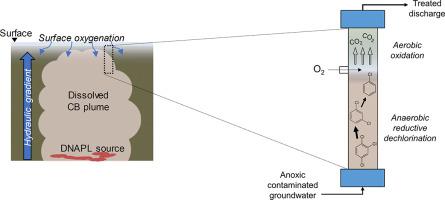Journal of Contaminant Hydrology ( IF 3.6 ) Pub Date : 2020-03-25 , DOI: 10.1016/j.jconhyd.2020.103639 Steven J Chow 1 , Michelle M Lorah 2 , Amar R Wadhawan 3 , Neal D Durant 4 , Edward J Bouwer 1

|
Halogenated organic solvents such as chlorobenzenes (CBs) are frequent groundwater contaminants due to legacy spills. When contaminated anaerobic groundwater discharges into surface water through wetlands and other transition zones, aeration can occur from various physical and biological processes at shallow depths, resulting in oxic-anoxic interfaces (OAIs). This study investigated the potential for 1,2,4-trichlorobenzene (1,2,4-TCB) biodegradation at OAIs. A novel upflow column system was developed to create stable anaerobic and aerobic zones, simulating a natural groundwater OAI. Two columns containing (1) sand and (2) a mixture of wetland sediment and sand were operated continuously for 295 days with varied doses of 0.14–1.4 mM sodium lactate (NaLac) as a model electron donor. Both column matrices supported anaerobic reductive dechlorination and aerobic degradation of 1,2,4-TCB spatially separated between anaerobic and aerobic zones. Reductive dechlorination produced a mixture of di- and monochlorobenzene daughter products, with estimated zero-order dechlorination rates up to 31.3 μM/h. Aerobic CB degradation, limited by available dissolved oxygen, occurred for 1,2,4-TCB and all dechlorinated daughter products. Initial reductive dechlorination did not enhance the overall observed extent or rate of subsequent aerobic CB degradation. Increasing NaLac dose increased the extent of reductive dechlorination, but suppressed aerobic CB degradation at 1.4 mM NaLac due to increased oxygen demand. 16S-rRNA sequencing of biofilm microbial communities revealed strong stratification of functional anaerobic and aerobic organisms between redox zones including the sole putative reductive dechlorinator detected in the columns, Dehalobacter. The sediment mixture column supported enhanced reductive dechlorination compared to the sand column at all tested NaLac doses and growth of Dehalobacter populations up to 4.1 × 108 copies/g (51% relative abundance), highlighting the potential benefit of sediments in reductive dechlorination processes. Results from these model systems suggest both substantial anaerobic and aerobic CB degradation can co-occur along the OAI at contaminated sites where bioavailable electron donors and oxygen are both present.
中文翻译:

模型实验室柱中含氧-缺氧地下水界面处 1,2,4-三氯苯的连续生物降解。
由于遗留泄漏,氯苯 (CB) 等卤化有机溶剂是常见的地下水污染物。当受污染的厌氧地下水通过湿地和其他过渡区排入地表水时,浅层的各种物理和生物过程可能会发生曝气,导致缺氧界面(OAI)。本研究调查了 1,2,4-三氯苯 (1,2,4-TCB) 在 OAI 中生物降解的潜力。开发了一种新颖的上流柱系统来创建稳定的厌氧和好氧区,模拟天然地下水 OAI。两个含有 (1) 沙子和 (2) 湿地沉积物和沙子混合物的柱子连续运行 295 天,并使用不同剂量的 0.14-1.4 mM 乳酸钠 (NaLac) 作为模型电子供体。两种柱基质都支持厌氧和好氧区域之间空间分离的 1,2,4-TCB 的厌氧还原脱氯和需氧降解。还原脱氯产生二氯苯和一氯苯子产物的混合物,估计零级脱氯速率高达 31.3 μM/h。受可用溶解氧的限制,1,2,4-TCB 和所有脱氯子产品均发生需氧 CB 降解。最初的还原脱氯并没有提高总体观察到的随后需氧CB降解的程度或速率。增加 NaLac 剂量会增加还原脱氯的程度,但由于需氧量增加,1.4 mM NaLac 会抑制需氧 CB 降解。生物膜微生物群落的 16S-rRNA 测序揭示了氧化还原区之间功能性厌氧和需氧生物的强烈分层,包括在柱中检测到的唯一假定的还原脱氯剂Dehalobacter。与沙柱相比,在所有测试的 NaLac 剂量下,沉积物混合物柱都支持增强的还原脱氯,并且Dehalobacter种群的生长高达 4.1 × 10 8拷贝/克(相对丰度 51%),突出了沉积物在还原脱氯过程中的潜在益处。这些模型系统的结果表明,在同时存在生物可用电子供体和氧气的污染地点,沿着 OAI,大量的厌氧和需氧 CB 降解可能同时发生。

























 京公网安备 11010802027423号
京公网安备 11010802027423号